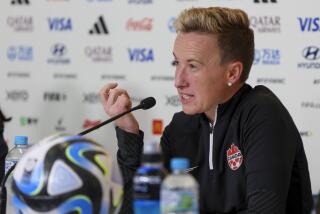Top women’s soccer players sue over artificial turf plans for World Cup

- Share via
It’s hard not to be amazed by the continuing incompetence of FIFA, world soccer’s clueless governing body.
Bribery scandals, opaqueness and general loathsomeness have come to define the organization over the last four decades. Now FIFA has managed to sink to new lows over its handling of next summer’s Women’s World Cup in Canada.
This time the issue is grass — or rather the lack thereof. Because while FIFA refuses to allow the men’s world championship to be played on anything other than natural grass, it’s essentially banned that surface from next year’s women’s tournament.
So a group of top players, led by U.S. stars Abby Wambach and Alex Morgan, have filed suit against FIFA and the Canadian Soccer Assn., contending artificial surfaces exacerbate injuries and change the game.
Oh, and then there’s also the suit’s claim of gender discrimination.
“It’s frustrating. And it’s sad that we’re even having to have this conversation,” U.S. national team midfielder Megan Rapinoe said. “From a gender-equality standpoint, I think we have a chance.”
So does Rocky Collis, an associate with the high-powered law firm of Boies, Schiller & Flexner, which joined two Canadian groups in challenging FIFA’s plans before the Human Rights Tribunal in Ontario, Canada.
“When the men say they want grass, they get it. And for the women, there just isn’t a concern on behalf of FIFA or Canadian soccer for what the women want or deserve,” Collis said.
“People in the soccer world know that artificial turf is considered a secondary surface. So to have the women’s premier tournament on a surface that everybody considers to be second class, it’s demeaning. And it’s a step back for the women’s game at a time when women’s sports should be taking steps forward.”
Canada was the only country that applied to stage the 2015 Women’s World Cup, and its bid specified that artificial turf fields, common in Canadian soccer, would be used for all 52 games. Defenders of that proposal say grass fields can be difficult to maintain in weather as severe as the Canadian winter.
“A late winter would bring incredible pressure to bear on preparing such grounds for the women’s World Cup,” Eric Harrison, an expert on artificial sports surfaces and a FIFA consultant, told FIFA.com. “The majority of stadiums in Canada have accepted that only … turf is a credible surface to meet the demands of the weather and usage to which they wish to subject the fields.”
That’s not entirely true. Winters are also severe in Germany and Sweden, and both countries have hosted women’s world championships on grass fields. And while five of the six stadiums the Canadians proposed for the World Cup had artificial fields, two of those surfaces — at Vancouver’s B.C. Place, site of the July 5 final, and Montreal’s Olympic Stadium — are largely unaffected by weather since the winters in Vancouver are mild and the stadium in Montreal has a roof.
The sixth venue, at the University of Moncton in Moncton, New Brunswick, had a grass field that World Cup organizers originally liked but eventually ripped out in favor of an artificial surface.
Meanwhile, suitable natural-grass fields, such as BMO Field in Toronto, which replaced its artificial surface with Kentucky bluegrass four years ago, and Saputo Stadium in Montreal, were ignored.
For the players, field maintenance isn’t nearly as important as safety and the quality of play, which is why a FIFA survey taken last year showed 77% of the women questioned wanted to play the World Cup on a natural field. It’s also why more than 70 players — including three former world players of the year in Wambach, Nadine Angerer of Germany and Marta of Brazil — are publicly backing the legal challenge.
Studies have shown abrasions, “turf burns,” lower-leg injuries and infections are more common on artificial surfaces, which are also harder than grass, leading to fatigue. All those factors make players reluctant to try headers or slide tackles, as they would on grass. Plus the ball moves faster and bounces higher on artificial turf, making it more difficult to control.
“It’s a completely different game on that surface,” Silvia Neid, coach of the German national team, told a women’s soccer journal.
With the tournament kicking off in a little more than seven months, there’s not enough time to replace the turf surfaces or relocate games to other cities. But it would be possible to put temporary grass over the artificial rugs, something FIFA did in the Pontiac Silverdome for the 1994 World Cup and the U.S. men’s team did in 2013 for a World Cup qualifier in Seattle.
Plus, installing temporary grass surfaces is a cheap fix, with estimates ranging from $3 million to $6 million to retrofit all six Canadian sites — about one-fifth the $27 million FIFA spent on a recent film about its president, Sepp Blatter.
Yet organizers consider that proposal a non-starter.
“We play on artificial turf and there’s no Plan B,” Tatjana Haenni, FIFA’s head of women’s competition, recently told reporters.
So expect the squabble over fields to be decided in a court, with the Canadian Tribunal last week ordering FIFA to respond to the players’ challenge by Nov. 6 or risk losing the case by default.
“It’s really more an issue of indifference toward the women’s game. And I think that symbolism is what really bothers,” said Collis, the attorney. “The solution is so easy it is a bit baffling that FIFA and/or Canadian Soccer haven’t just stepped in already to say, ‘All right, let’s talk about a way to fix this.’ ”







